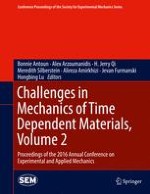2017 | Buch
Challenges in Mechanics of Time Dependent Materials, Volume 2
Proceedings of the 2016 Annual Conference on Experimental and Applied Mechanics
herausgegeben von: Bonnie Antoun, Alex Arzoumanidis, H. Jerry Qi, Meredith Silberstein, Alireza Amirkhizi, Jevan Furmanski, Hongbing Lu
Verlag: Springer International Publishing
Buchreihe : Conference Proceedings of the Society for Experimental Mechanics Series
